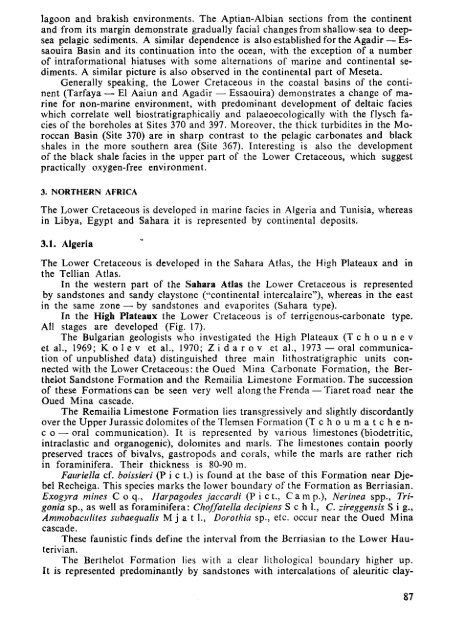THE MEDITERRANEAN LOWER CRETACEOUS
THE MEDITERRANEAN LOWER CRETACEOUS
THE MEDITERRANEAN LOWER CRETACEOUS
You also want an ePaper? Increase the reach of your titles
YUMPU automatically turns print PDFs into web optimized ePapers that Google loves.
lagoon and brakish environments. The Aptian-Albian sections from the continent<br />
and from its margin demonstrate gradually facial changes from shallow-sea to deepsea<br />
pelagic sediments. A similar dependence is also established for the Agadir — Essaouira<br />
Basin and its continuation into the ocean, with the exception of a number<br />
of intraformational hiatuses with some alternations of marine and continental sediments.<br />
A similar picture is also observed in the continental part of Meseta.<br />
Generally speaking, the Lower Cretaceous in the coastal basins of the continent<br />
(Tarfaya — El Aaiun and Agadir — Essaouira) demonstrates a change of marine<br />
for non-marine environment, with predominant development of deltaic facies<br />
which correlate well biostratigraphically and palaeoecologically with the flysch facies<br />
of the boreholes at Sites 370 and 397. Moreover, the thick turbidites in the Moroccan<br />
Basin (Site 370) are in sharp contrast to the pelagic carbonates and black<br />
shales in the more southern area (Site 367). Interesting is also the development<br />
of the black shale facies in the upper part of the Lower Cretaceous, which suggest<br />
practically oxygen-free environment.<br />
3. NOR<strong>THE</strong>RN AFRICA<br />
The Lower Cretaceous is developed in marine facies in Algeria and Tunisia, whereas<br />
in Libya, Egypt and Sahara it is represented by continental deposits.<br />
3.1. Algeria<br />
The Lower Cretaceous is developed in the Sahara Atlas, the High Plateaux and in<br />
the Tellian Atlas.<br />
In the western part of the Sahara Atlas the Lower Cretaceous is represented<br />
by sandstones and sandy claystone ("continental intercalaire"), whereas in the east<br />
in the same zone —• by sandstones and evaporites (Sahara type).<br />
In the High Plateaux the Lower Cretaceous is of terrigenous-carbonate type.<br />
All stages are developed (Fig. 17).<br />
The Bulgarian geologists who investigated the High Plateaux (Tchounev<br />
et al., 1969; К о 1 e v et al., 1970; Z i d a r о v et al., 1973 — oral communication<br />
of unpublished data) distinguished three main lithostratigraphic units connected<br />
with the Lower Cretaceous: the Oued Mina Carbonate Formation, the Berthelot<br />
Sandstone Formation and the Remailia Limestone Formation. The succession<br />
of these Formations can be seen very well along the Frenda — Tiaret road near the<br />
Oued Mina cascade.<br />
The Remailia Limestone Formation lies transgressively and slightly discordantly<br />
over the Upper Jurassic dolomites of the TIemsen Formation (Tchoumatchenc<br />
о— oral communication). It is represented by various limestones (biodetritic,<br />
intraclastic and organogenic), dolomites and marls. The limestones contain poorly<br />
preserved traces of bivalvs, gastropods and corals, while the marls are rather rich<br />
in foraminifera. Their thickness is 80-90 m.<br />
Fauriella cf. boissieri (P i с t.) is found at the base of this Formation near Djebel<br />
Recheiga. This species marks the lower boundary of the Formation as Berriasian.<br />
Exogyra mines С о q., Harpagodes jaccardi (P i с t., Cam p.), Nerinea spp., Trigonia<br />
sp., as well as foraminifera: Choffalella decipiens S с h 1., С. zireggensis S i g.,<br />
Ammobaculites subaequalis M j a t I., Dorothia sp., etc. occur near the Oued Mina<br />
cascade.<br />
These faunistic finds define the interval from the Berriasian to the Lower Hauterivian.<br />
The Berthelot Formation lies with a clear lithological boundary higher up.<br />
It is represented predominantly by sandstones with intercalations of aleuritic clay-<br />
87

















